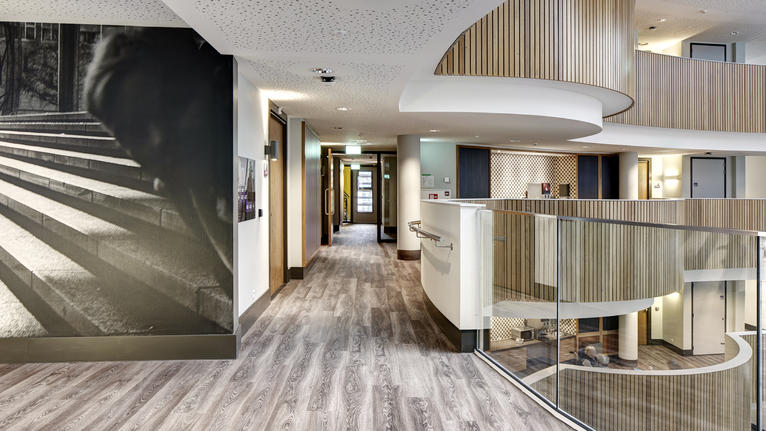
4 challenges facing the European Healthcare Sector
And how our flooring solutions help address these challenges
The constant ageing of the population as well as the decrease in public expenditure in most European Countries (OECD Health Statistics 2016; Eurostat Database) have increased the number of challenges facing Healthcare sector Management and Staff every day. These challenges are all very diverse, from improving patient experience to maintaining high levels of hygiene or optimizing the budget while ensuring a high quality of service and staff. Here are some of the main challenges commonly faced by Hospital or Healthcare facility Managers and Staff, and how Tarkett can help deal with these challenges.
Improving patient experience
The first of these challenges is to provide patients with the best healing environment possible. This means an environment in which they will heal faster because, apart from the medical treatments they will receive from the medical staff, the environment they live in (their room, the operation theatre, where their wheelchair goes, etc) has various features that are essential for a patient’s well-being. For example, a better healing environment is one in which the indoor air quality is good, in which the floorings, walls or paint do not retain bad germs. Floorings like homogeneous vinyl, the iQ range or linoleum have very low VOC emissions (< 10 µg/m3) and therefore make for a very healthy indoor air quality. The VOC emissions of these ranges are well below the European Standard regulation (< 1000 µg/m3). Our products are also manufactured with a phthalate-free technology. This means we use plasticizers approved as safe for food containers for children.
The aesthetic dimension is very important for patient’s well-being. The practical applications of colour, pattern, texture and the reflection of light (also known as Light Reflectance Value. LRV measures the percentage of light that a surface reflects) are essential in order to create interiors that have a positive influence on people. They help reduce stress and can better identify, unify or separate spaces. It’s even more important in an aged care unit, where interior design is key to improving Alzheimer patient comfort and safety and proving an easier orientation throughout the building. Also essential is the perception of a cleaner appearance thanks to stains and marks that are less visible.
Another very important aspect of a healing environment is the noise level. A patient needs calm and rest to heal. However, Hospitals are noisy places because of the constant movement in the corridors, and the number of people living in these health facilities. The ceiling, flooring and walls can obviously contribute to making the spaces less noisy. For instance, certain floorings can reduce the noisiness by up to 20dB.
Last but not least, a patient's well-being will also depend on how safe he or she is. Showers for instance are potentially risky if they are slippery or do not have anti-slip features. Our special wet room floorings are a good solution option to avoid these falls in patient bathrooms.
Optimizing a constrained budget with durable and low maintenance solutions
Improving patient experience is of course very important but there are constant budget limitations that need to be taken into account. Hospital administration teams have tight budgets they need to fit into. Two important aspects to look into when choosing flooring products is the durability and the maintenance cost, which also includes the cleaning labour costs.
For example, Tarkett’s homogenous vinyl and linoleum products have a lifespan of 20 to 25 years and are highly resistant to abrasion and stains, allowing you to reduce maintenance and cleaning costs by 24 to 30%, as proven by Tarkett’s life cycle analysis. Also, the fact our products have a PU surface treatment means that our homogeneous and heterogeneous vinyl as well as our linoleum products require no strip, polish or wax, making for huge cost savings and easier cleaning protocols.
Exceeding standards when it comes to hygiene with expert flooring and wall solutions
Hospitals and healthcare facilities are areas that need to prevent infection risks. The materials used in the construction of the building can help maintain the required levels of hygiene to prevent germs and therefore diseases from spreading. Flooring and walls are strategic product choices to handle this particular challenge since they can become a carrier of germs because of spilt chemicals or liquids, people walking and coming in from outside the Hospital. This can also be the case if the floor isn't cleaned as often as it should.
Tarkett’s floorings all exceed the highest standards for cleanrooms , achieving Fraunhofer Institute’s ISO4 certification*. This is a level above the ISO5 requirement commonly specified for such demanding environments. Available in static-conductive and –dissipative formats, Tarkett flooring and wall coverings are perfectly smooth, impervious and easy to clean.
*The iQ and ProtectWall 2CR ranges are ISO4 and ISO1-certified respectively.
Integrated solutions for easier renovations
Planning to renovate part of a Hospital or Healthcare facility? For a Healthcare Facility Manager, choosing construction products from multiple suppliers is bound to be complicated, time-consuming and more expensive. However, you may think this is sometimes necessary because not all suppliers have the products you need to meet your expectancies in terms of durability, design, sound reduction or functionality. This is why Tarkett offers integrated solutions that include not only floorings but also wall coverings and accessories that can be combined and are highly durable.
On top of this, Tarkett is a responsible partner. We consider that preserving the environment for future generations is the best way to do business. For this reason, all of our activities are built around four pillars that drive the way we produce and do business:
• using good materials that are abundant, rapidly renewable and easily recycled,
• using renewable energy whenever possible and implementing strategies to optimize resources,
• contributing to people-friendly spaces, with low TVOC emission products, and finally,
• reusing materials (with our Restart® Programme).